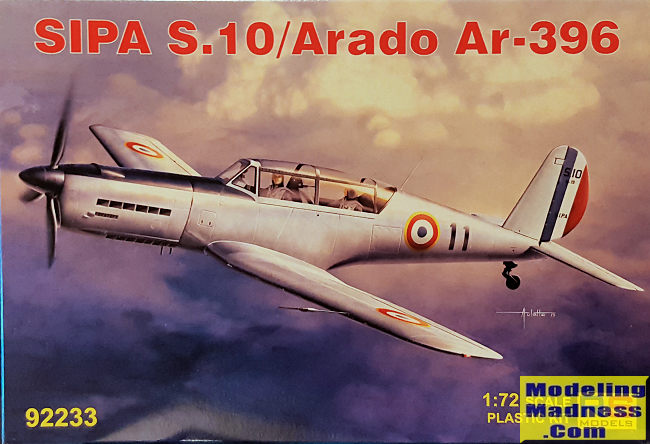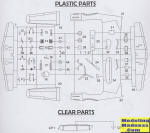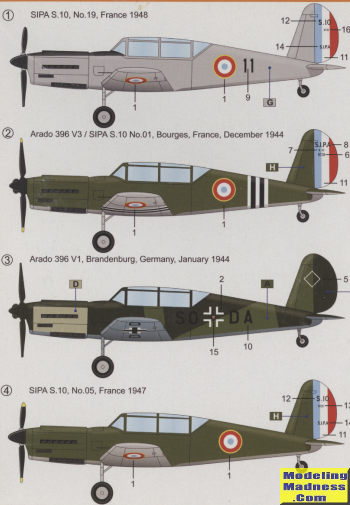
RS Models SIPA S.10/Ar-396
| KIT #: | 92233 |
| PRICE: | ~$20.00 |
| DECALS: | Four options |
| REVIEWER: | Scott Van Aken |
| NOTES: | Short run kit |

| HISTORY |
The Ar 396, designed as a wooden replacement for the Ar.96, was built in France and Czechoslovakia. A few of the Czech built aircraft reached the Luftwaffe and none entered service. After the liberation of France, the French continued production, designating the aircraft the SIPA S.10. Further developments were the SIPA S.11 (armed version), and the SIPA S.12, a metal version; 188 of all versions were produced until 1958. The S.11 was operated with some success in Algeria, carrying machine guns, rockets and light bombs.
Very early in French production, the design of the landing gear was changed. .Instead of simply retracting into the wing and leaving a portion of the wheel exposed, the wheel was designed to turn 90 degrees during retraction to fit flush in the wing. The aircraft also soon adopted a three blade propeller to replace the original two blade version. Approximately 175 aircraft of all variants was built in France.
| THE KIT |
 After
previewing the Huma Ar-396 a bit back, I did a search to see if anyone else had
done this model. I was surprised to see that RS Models also did one and that
they also marketed it as a SIPA S.10.
After
previewing the Huma Ar-396 a bit back, I did a search to see if anyone else had
done this model. I was surprised to see that RS Models also did one and that
they also marketed it as a SIPA S.10.
The quality of the moldings is quite good though it is still what I'd call a short run kit so should be assembled as such. There are a few ejector bits to deal with, but that seems to be about it. The cockpit is fairly basic with a floor, seats, stick and a back bulkhead, something the Huma kit was missing. You also have amore complete engine assembly to stick behind the intake. A forward bulkhead stops the see-through issue and when you close the halves, you then install the front instrument panel (which, like the rear one you'll install later, has no instrument detail. Nor is there a decal.
 With the
fuselage halves closed, it is time to decide if you will do an Ar-396 or SIPA
S.10. The S.10 takes a three blade prop which is installed into the separate
forward cowling piece. Then you assemble the wings. While RS gives you two lower
wings, it only shows the one for the S.10. The Ar-396 wing has the wheels
partially showing when retracted, so if doing one of those two options, use that
wing. The one with the larger openings is for the S.10
With the
fuselage halves closed, it is time to decide if you will do an Ar-396 or SIPA
S.10. The S.10 takes a three blade prop which is installed into the separate
forward cowling piece. Then you assemble the wings. While RS gives you two lower
wings, it only shows the one for the S.10. The Ar-396 wing has the wheels
partially showing when retracted, so if doing one of those two options, use that
wing. The one with the larger openings is for the S.10
Like the Huma kit, the rudder is separate as is the horizontal stab and the canopy is a single piece. Again, the instructions only show the S.10 undercarriage. However, the bits for the Ar-396 are there for you to use. Same goes for the exhaust. I should also mention that the bits for the armed S.20 are included on the sprues but are not germane to the markings options provided.
 Instructions
are nicely drawn and quite adequate. However, just as none of the Ar-396 bits
are shown, also not provided are any sort of interior color information. The
nicely printed decals offer two SIPA S.10 and two Ar-396 options. The first and
fourth are the SIPA S.10 while the middle two are Ar-396s.
Instructions
are nicely drawn and quite adequate. However, just as none of the Ar-396 bits
are shown, also not provided are any sort of interior color information. The
nicely printed decals offer two SIPA S.10 and two Ar-396 options. The first and
fourth are the SIPA S.10 while the middle two are Ar-396s.
| CONCLUSIONS |
I find it a bit of a shame that RS couldn't provide sufficient information to build half the markings options planes, but I'm sure they did that so they could get everything on a single sheet of paper. However, this kit is a step ahead of the older Huma kit in terms of detailing and I'm sure it fits better as well. If you like trainers of this era, it would be worth picking up.
March 2020
Copyright ModelingMadness.com
If you would like your product reviewed fairly and fairly quickly, please contact the editor or see other details in the Note to Contributors.